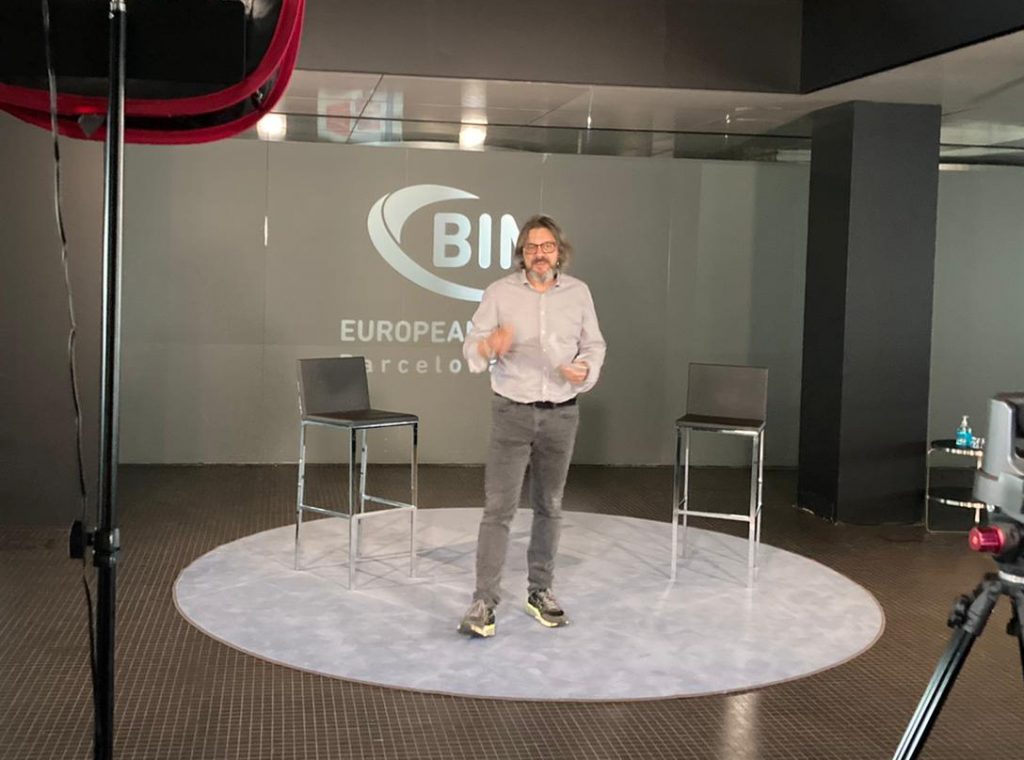The Col·legi d’Aparelladors, Arquitectes Tècnics i Enginyers d’Edificació de Barcelona [Association of Surveyors, Technical Architects and Building Engineers of Barcelona] (CAATEEB) is working to organise the next European BIM Summit, due to be held on June 3 in the Barcelona World Trade Center and which will also be streamed worldwide simultaneously.
The Covid-19 pandemic has obliged us to rethink how we engage with any area of society and also to expedite the necessary changes in areas in which hitherto productivity was somewhat under-optimised, such as the construction industry. In one year, digitisation in the AECO sector has increased the equivalent of five.
Last year’s European BIM Summit was totally digital, with an excellent turnout and very positive conclusions. “We have learnt from experience”, said the Project Leader of the European BIM Summit and BIM Leader of the CAATEEB, Rafael Capdevila, in the course of EBS Day 2021. “Virtualisation allows people from all over the world to connect online simultaneously”.
Nevertheless, attendance-based events also provide that extra close-contact touch in the form of networking, which is why the seventh edition of the BIM International summit will not be forgoing this traditional format, evidently taking the necessary health protection measures.
Three collaborative working documents
The formula chosen for the Congress will be replicating the last edition’s: three main topics about which world experts are already drafting the working documents to be debated in the round tables. Once these documents are available, they will be sent out to the attendees; case studies with an international scope and presentations by renowned professionals.
Towards Construction 4.0 is the Congress’s slogan, a topic that will be explored in depth in the form of the collaborative BIM Execution Plan (PEB), the Industrialisation of Construction, and the Digital Twin for data use in BIM models. The objective: to generate and disseminate knowledge in the area of digital construction technologies from a collaborative standpoint, with sustainability providing one of the cornerstones for the sector’s reconversion.
BIM has transitioned from the dissemination phase to the applicability phase. Property developers and ownerships want to make their implementation tangible, teams need alternative mechanisms to share what is now critical information, builders want to be able to use information on-site effectively and some are already looking upon it as a new business.
Its effects on professional functions and responsibilities open up a new area in terms of legal and judicial impacts. The hiring of open teams must become a reality in public procurement, as is now being called for by the European directives. City managers have great expectations for the possibilities of managing the digital models of buildings and infrastructures. The Digital Twin and the parameters it has to contain need to be defined.
The collaborative BIM Execution Plan
The BIM Execution Plan is the cornerstone of the entire process behind a building project. It is the core tool in organising the flows of information generated, although each site or project usually has its own BEP and putting it into practice is not always that straightforward. The objective of the European BIM Summit is to prepare a BEP Implementation guideline. The creators of the BIM Execution Plan in the United States, of the highly-regarded Latin American BEP and a member of the Australian NATSPEC, the construction standardisation agency from “down under”, have been tasked with drafting the collaborative document that will be debated at the Congress’s first round table on June 3.
The industrialisation of construction
Industrialising construction means making it more efficient and productive, simplifying processes, optimising costs and avoiding delays. The authors of the “Modernise or Die” report commissioned by the British government and one of the representatives of the alliance between Toyota and Panasonic for the building of fully-equipped industrialised housing are already working on the second document that will be presented at the second round table of the European BIM Summit 2021.
The Digital Twin connected to the BIM environment
The Digital Twin is rapidly gaining ground in the AECO sector thanks to the way it facilitates the management of built assets and improves sustainable criteria. The young Building Digital Twin Association and the successful start-up WeWork, which explores the possibilities of BIM as a key part of its global coworking model in depth, are working together on the document about the most advanced experiences and future areas of work related to the Digital Twin.
The participants at the European BIM Summit 2021 will get to interact with the speakers and will be able to provide their own insights to the working documents thanks to the BIM App, which was already operational at last November’s event.
One of the main reasons why of this experience is precisely the way that it encourages the participation and exchange of ideas among professionals from all over the world, something which, in the true BIM collaborative spirit, helps to enrich discussion and therefore further the knowledge generated at the Congress.
Registration is already open, and a 50% discount will be available until March 15. Don’t miss out on the European BIM Summit 2021!
The European BIM Summit is organized by the Col·legi d’Aparelladors, Arquitectes Tècnics i Enginyers d’Edificació de Barcelona (CAATEEB) and is possible thanks to the contribution of our sponsors: BIM Academy i buildingSMART Spain, as Content partners; Roca, as Main partner; Finalcad, as Gold partner; Agència Catalana de l’Aigua, ATL, Bentley, ASP Corredoria d’Assegurances, CIAT, FGC, MUSAAT, PREMAAT, SIMBIM Solutions, Graphisoft Archicad and Suez, as Silver partners; Calaf Constructora, Copisa and Fundación Laboral de la Construcción, as Pro partners; and Master Builders Solutions, as Sustainability sponsor. It has also the support and the collaboration of the Departament de Territori i Sostenibilitat of the Generalitat de Catalunya.






